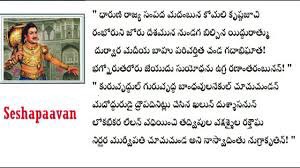

Nannayya, while maintaining the spirit of this SAstra, took liberties with the kAvya element of the text. According to the scholars who critiqued the text, the focus of Vyasa’s Mahabharata rested on the SAstra.

It also cannot be termed as a reconstruction or a retelling. I use the term “Andhreekarana” instead of “translation” because Nannayya’s style of composition cannot be termed as a true translation of Krishna Dwaipayana Vyasa’s Moola Mahabharata. The work earned him the titles “Sabda SAsana” and “vAgAnuSAsana”.Īfter carving the linguistic path for the Telugu language, Nannayya started on the Andhreekarana of Mahabharata. Thus, he took on the job of scrutinizing Telugu vocabulary, and produced the “Andhra Shabda Chintamani”, a grammatical treatise in Telugu, largely inspired from Panini’s Ashtadhyayi, while sticking to a five-fold grammatical structure (samjnā, sandhi, ajanta, halanta, kriya, as per “A Comparative Study Of Andhrasabdachintamani And Balavyakaranam”). Telugu, as a language, lacked an independent grammatical structure in his days. Nannayya, who empathized with Raja Raja Narendra’s observations, had a daunting task before him. This led to his requesting Nannayya Bhattaraka to take upon the task of translating the fifth Veda to Telugu. The due respect of the householders, who were critical to any State, he believed, could be restored only by restoring Vedic thought through a language appreciated by the common folk. Raja Raja Narendra’s concern rested on the glorification of renunciation by Jain culture and the undermining of the householder (“grihastha”) who was actually the social, cultural and economic backbone of the household, society and the State. Adding to this, Pampakavi had composed “Vikramarjuna Vijaya”, a retelling of the Mahabharata in Kannada, in which he established the supremacy of the Jain thought over the Vedic thought. Vedic literature, on the other hand, was a captive of a few scholars who had the knowledge of Sanskrit, and common folk had begun to feel uncomfortable about depending upon them. He observed that the Jaina and Bauddha traditions endeared themselves to the common folk by having their literature available in the common tongue. Raja Raja Narendra prevailed, and he ascended the throne with some observations of common folk that he made in this course. In the strife that ensued, Vijayaditya was supported by the Western Chalukyas, while the Chola emperor Rajendra supported his nephew. She was a follower of the Shaiva thought. Raja Raja Narendra’s mother, Kundavamba, was a Chola princess and the sister of Rajendra Chola-I. Vijayaditya was influenced by his mother, Princess Melavamba, who was sympathetic to the Jain cause. Upon Vimaladitya’s death, he faced opposition from his step-brother Vijayaditya. Raja Raja Narendra was the son of King Vimaladitya.

The political conditions that led to his ascension did have a bearing on the translation of the Mahabharata. Nannayya, who existed in the 11th Century CE, was the guru of Raja Raja Narendra, the Eastern Chalukyan King who ruled over Vengi. The scope of this post is to observe the conditions that inspired each of the poets to take up this work.Īdikavi Nannayya. These three poets are collectively called as Kavitrayam (“Poet Trinity”) among the Telugu literary sphere. It took close to 300 years for this book to reach completion. The Telugu version of the epic Mahabharata has a unique distinction of being composed by not one, but three poets belonging to three different generations. The conditions that led to the composition of Andhra Mahabharatamu validate the quote. This is a loose translation of a statement made in the preface to the Andhra Mahabharatamu edition by Tirumala Tirupati Devasthanams (TTD). Whenever the Vedic legacy faces a crisis, the fifth Veda, which is the Mahabharata, takes a new shape to redefine Dharma.


 0 kommentar(er)
0 kommentar(er)
